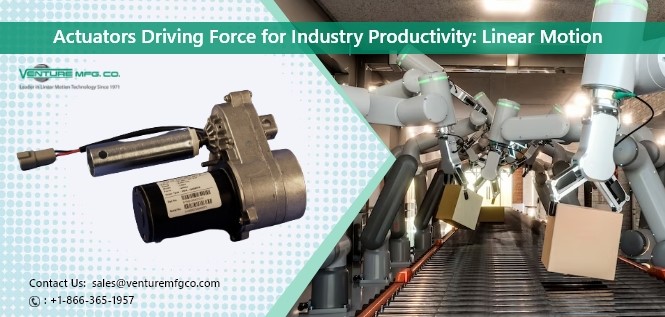Without motion, whether rotational or linear, it would be impossible for most industrial machines and equipment to function and yield any output. It is required at every stage of the production process, on assembly lines, in packaging, labeling, material handling, loading for shipments, and more. So, it would not be an overstatement to say that linear motion drives productivity across industries. Actuators are key devices which play a major role in facilitating this motion and even converting it from linear to rotational and vice-versa. Linear actuators are used in a number of these machines and equipment such as pick-n-place equipment, assemblies, conveyor belt, material handling equipment in warehouses, and more. This post discusses how electric linear actuators help boost motion, the ongoing developments in actuation, and more.

Why Linear Motion is the Driver of Industrial Productivity?
Here are some pointers why linear motion systems hold prominence.
- All the machines and equipment mentioned above that work on actuation systems have significantly increased the speed of production, reduced manual intervention, especially in risky or mundane jobs, and helped cut down on time and costs.
- Linear actuators also offer precision and fast response times. Conveyor belts that facilitate all the stages of a product that moves along the assembly line, is filled, sealed, and packed on the same line.
- Equipment and devices with electric linear actuators have been efficiently used in mission critical applications where there is zero tolerance for errors. These include medical devices aerospace systems, chairs, beds, and other movable equipment used in these sectors. All of this can be achieved owing to linear motion systems.
- The other advantages of these actuators are reduced noise and friction when operating, reduced wear of equipment, and others.
- All of this helps cut down on costs, downtime, production and packaging errors, and increases time to market of products.
- All these benefits of actuation systems have prompted further research and development.
Developments in Actuation Systems
According to some market research reports, the market for linear actuators is projected to grow to $169.69 billion by 2029 at a CAGR of 8.2%. This is an encouraging growth rate, and there is much research going on to test the applications of linear motion systems in niche segments as well. Here are some relevant pointers.
- Active foil bearings is one such segment where the application of actuation systems is being developed. Here, actuators are used to control torque, reduce rotor vibration, and modify the bearing sleeve size.
- Another segment is simulation systems and demonstrators for off-the-shelf devices such as ball screw drives. Actuators here may be used for smoothening the signal using moving average, and determining other factors in movement such as settling time, standard deviation, and so on.
- Robotics, as a segment, have been using actuators for decades. However, there are newer developments in terms of artificial muscles to improve the structural scalability in bots and other relevant areas.
If you are an OEM and manufacture mechanical or electronic parts or products which are fitted in industrial systems, you would likely require good quality linear actuators with stepper motors. Ensure you source linear actuators from a well-known and reliable manufacturer and supplier. Also, check all the customization options to suit your needs. Venture Manufacturing is a reliable manufacturer and supplier of a variety of electric linear actuators such as heavy duty, high speed, and motorized. They can also provide all the related accessories.
